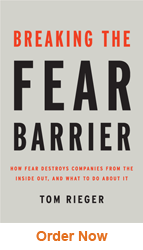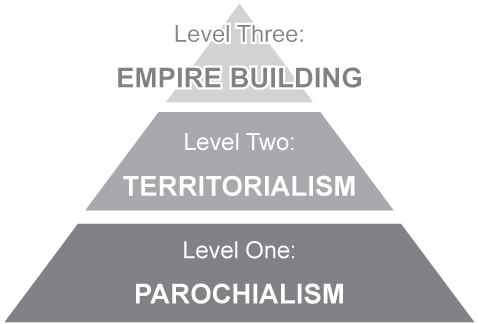A few years ago, Tom Rieger was confronted with a mystery. He'd been called in to help some organizations that were, in their words, "stuck." These organizations were seemingly well-managed, but they still struggled with high employee turnover, low customer engagement, and a variety of other problems -- for no apparent reason.
The biggest threat to an organization's success: the fear that lives within its own walls.
So Rieger, a senior practice expert at Gallup, and a handpicked team of consultants dug in to find out what was wrong. "We looked at policies and procedures, performance management systems, and organizational charts," Rieger says. "We studied every level from the C-suite to the graveyard shift and every aspect of every job -- recruiting, hiring, training, discipline, advancement, attrition -- you name it."
Pretty soon, Rieger and his team realized that these organizations seemed to have little in common -- except that all of them had erected thick internal barriers. "There were collections of bureaucracies, and each had been created out of fear," Rieger says. "Over time, as these organizations grew and became more complex, fear of loss led to bureaucracy, inefficiency, low morale, and ultimately, failure."
The closer Rieger looked, the more he realized that fear was eroding all these organizations in very similar ways. So similar, in fact, that the pattern could be easily recognized if one knew what to look for. To help organizations do just that, Rieger wrote the book Breaking the Fear Barrier: How fear destroys companies from the inside out and what to do about it, out this month from Gallup Press.
In this conversation, Rieger discusses the root cause of fear and how it leads to barriers. He explains the patterns to look for and what creates them. Finally, he talks about what leaders should know about fear, how they can dismantle the barriers that already exist -- and the rewards in store for leaders who do.
GMJ: Are bureaucracies and barriers inevitable in any organization?
Tom Rieger: I think to a large extent, they are inevitable in any organization that's growing. As organizations grow and divide up responsibilities, people feel endowed with control over certain departments, and that endowment leads to a desire to protect, which leads to barriers.
The biggest threat to an organization's success isn't necessarily the competition -- often, it's the fear that lives within its own walls. That fear leads to all sorts of problems and causes people to believe that they need to create walls and barriers to protect themselves, even though those walls and barriers make it harder for others in the organization to succeed. And it's that dynamic -- how fear creates barriers and bureaucracy and how you can get to the root of fear and overcome it -- that the book is meant to address.
GMJ: What causes that dynamic?
Rieger: It's caused primarily by a fear of loss -- fear of not getting a bonus, not meeting a goal, losing decision rights, losing something. Sometimes fear affects a single person, but sometimes fear is a departmental issue. For example, your organization may have an inventory control group that's incented to make sure the warehouse is empty at the end of the month and a sales group that's incented to make sure there's always product in the warehouse to sell. One of those two groups will fail at meeting its goal. And one of the groups may be so scared of failure that it will create rules that make it easier for it to succeed and harder for the other group. Those rules may even make some sense, but in actuality, they're a barrier for the organization overall.
GMJ: Who starts building these barriers? Everybody? Or just people with power?
Rieger: The root cause of the barrier is typically someone who has power and is out to protect it. The manifestation of the barrier is usually among those who are subject to it. But there is definitely a sequence to the building of barriers. As I said, it starts with the division of responsibilities and control.
As an organization becomes more complex, there are more demands on each department. That leads to the first level of the pyramid of bureaucracy, which we call parochialism: when the view of success becomes defined not necessarily by organizational success but by what a department is asked to do. The department begins to view its world as the piece and not the puzzle. That promotes a connection to a small part of the process but causes loss of connection to the overall outcome.
In the face of that parochialism and as resources become tighter, some departments or individuals tend to want to exert an extreme amount of control over the people or resources in their area or at their disposal. This leads to the second level of the pyramid of bureaucracy, territorialism. Territorialism is extreme control over resources and headcount.

The third and final level is empire building, which occurs when self-sufficiency becomes threatened, often because of all this territorialism and parochialism. Empire building is an attempt to seize control of others or decisions or resources to regain self-sufficiency. All of these things lead to waste, inefficiency, lost opportunities, and cost.
We studied a large financial institution that was a textbook example of this. Its employees had struggled with tightening margins and increased competition, and the resulting fear led to the creation of all three levels of the pyramid. The result was disengagement and inefficiency -- and in the customer service group, very poor call resolution and customer engagement. Once these barriers were removed, however, we saw increases in engagement, increases in first-call resolution, and sharp increases in how customers felt about the bank.
GMJ: What is leadership's role in removing the root causes of barriers -- of overcoming fear?
Rieger: Leaders must drive these improvements; they must actively seek out and eradicate these barriers, because doing so may require some cross-functional authority. But beyond that, leaders need to create an environment where courageous behavior can thrive -- where what's best for the individual is in perfect alignment with what's best for the organization.
GMJ: What does that environment look like?
Rieger: A courageous environment has a few key characteristics. First, you need engaged employees. They create the energy that's required to drive the result that you're hoping for. Second, you need to make sure that you're rewarding the right things and that you're not inadvertently setting up systems that are too process-focused. The right incentives should encourage people to do what's right for the broader organization, not necessarily just one individual department. Most of all, you must clearly define a mission that the entire organization can become aligned around. Your goals, your systems, your performance, your recognition all should tie back to the overall mission. The other side of the coin, however, is that you must watch out for what I call courage killers.
GMJ: What are courage killers?
Rieger: Courage killers usually come from lower level managers and supervisors. For instance, a manager can express that employees are empowered at their own risk, encouraging them to take a risk and then punishing them if it doesn't work out. Managers may reward subjective metrics or subservience over service; the yes-man will win over the person who made a riskier, more courageous decision. Managers can be inconsistent, not standing behind their employees even though they may have approved their actions, or they can overreact to problems instead of treating them as learning opportunities.
GMJ: Let's say an organization has done the hard work of rooting out barriers -- but resources are still limited. How can it prevent fear from creeping back in?
Rieger: Fear will always be there, and you must always work to align the organization around what's most important. It helps to define a set of guiding principles based on overall success: financial success, a better workplace, better relationships with customers, avoiding risk or catastrophic failure, for example. Every resource decision should be made based on what creates the maximum return on those overall metrics of success.
GMJ: Does that require a flat organizational structure?
Rieger: Not necessarily. It does require an aligned management team, and as their decisions are cascaded throughout the organization, there must be some linkage from each department's purpose back to the overall mission.
GMJ: What does a fearless organization look like?
Rieger: A fearless organization will become -- as much as it can -- barrier free. It is a much more dynamic place. People work cross-functionally, go out of their way to do the right things, and have absolute clarity about the ground rules and boundaries and absolute freedom within those boundaries.
And then, of course, they're often much more successful. We've seen quantum improvements in engagement and performance when barriers have been addressed. Ultimately, barrier-free workplaces just feel different -- I've seen it happen. You can feel the energy and engagement as soon as you walk through the door.
-- Interviewed by Jennifer Robison
